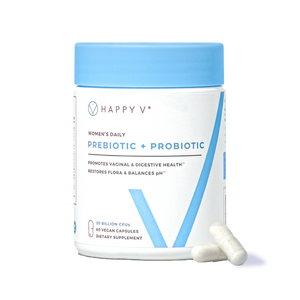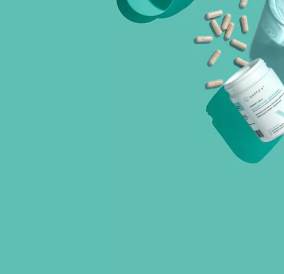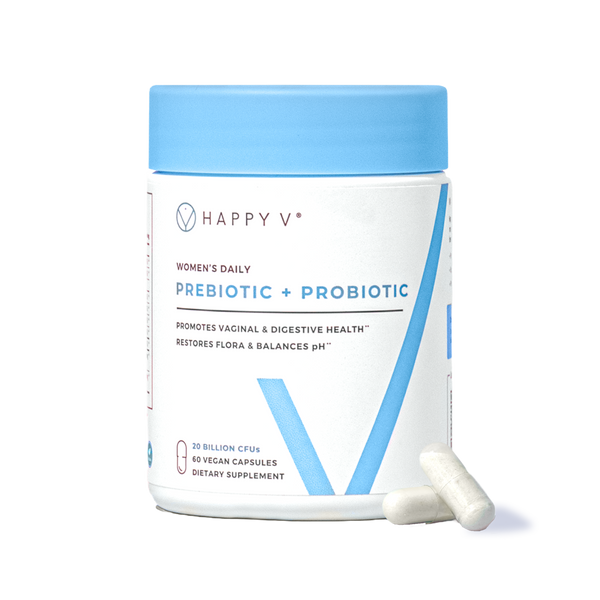- Fact Checked
- June 16, 2025
- 15 min read
What Is HPV: What You Need to Know About Diagnosis, Screening & More
Table of Contents
Table of Contents
If you've heard about HPV and felt confused about when you should get tested, what the tests actually look for, or what the heck HPV even is, you're not alone.
HPV, or human papillomavirus, is the most common sexually transmitted infection, but also one of the most misunderstood. When many people hear “HPV,” they think “cancer,” but the truth is that most people clear HPV without any symptoms or complications. Some high-risk HPV types, though, can cause cell changes that, if left undetected, may develop into cervical cancer or other HPV-related cancers over time. The keyword here, though, is “left undetected.” Regular screening can catch those changes early, often years before they turn into something serious.
The reality is, you can protect yourself from HPV, and if you are ever diagnosed as HPV-positive, there is plenty you can do to preserve your long-term health.
This post is for informational purposes only and does not constitute medical advice. See full disclaimer below.
What is HPV?
HPV isn’t just one virus. It’s actually a whole family of over 100 related viruses1. Not all of them are sexually transmitted, and not all of them cause serious health issues. Each HPV virus falls into one of two categories: low-risk and high-risk.
Low-Risk HPV Types
Low-risk HPV types, like HPV 6 and HPV 11, are not associated with cancer2. So that’s good news. However, they may cause genital warts (aka those small, cauliflower-like bumps that can appear on the vulva, vagina, cervix, penis, or anus). These warts aren’t dangerous but they can be annoying, and many ultimately require treatment to remove them.
High-Risk HPV Types
High-risk HPV types, particularly HPV 16 and HPV 18, are the ones linked to most HPV-associated cancers, including cervical cancer3.
That’s because these strains can cause cell changes in the cervix, vagina, vulva, anus, penis, and even the throat4. Over time (we're talking years or even decades), these abnormal cells can develop into precancerous changes or cancer if they're not detected and treated.
By some estimates, HPV 16 and HPV 18 are responsible for about 70% of all cervical cancers. Instead of letting that scare you, take it as a reminder to get screened for HPV regularly, even if you feel perfectly healthy. As for how often exactly you should be screened, we’ll get into that a bit later.
How Is HPV Transmitted?
Not all HPV viruses are sexually transmitted, but it is spread most commonly through vaginal sex, anal sex, oral sex, and general intimate skin-to-skin contact like hand-to-genital contact (though this is less common)5. It cannot be passed through kissing, toilet seats, swimming pools, sharing towels, or casual touching.
It’s important to know that HPV can be passed from person to person even when there are no symptoms or warts present6. Understanding how HPV spreads is the first step in protecting yourself. HPV is passed through intimate skin-to-skin contact, which means it can be transmitted even when there are no visible symptoms or warts present. In fact, most people who transmit HPV have no idea they're carrying the virus. That may be why it’s one of the most common sexually transmitted infections.
Who Is at Risk for HPV?
We aren’t about scare tactics, but we do want to be straight-up with you: if you're sexually active, you're at risk for HPV.
The CDC estimates that nearly all sexually active people will get at least one type of HPV at some point in their lives, but certain factors can increase your risk, especially:
- Having multiple sex partners (or being with someone who has multiple sex partners
- A weakened immune system due to HIV, immunosuppressive medications, or other chronic health conditions
- Smoking (another reason to quit or not start!)
- Chronic stress
- Direct contact with visible genital warts
- Not being vaccinated
How Is HPV Diagnosed?
Unlike some infections that cause obvious symptoms, most HPV infections fly under the radar7. That's why diagnosis usually happens during routine screening. Here are the screenings that most often lead to an HPV diagnosis:
HPV Test
Makes sense, right? An HPV test is one that specifically looks for signs of high-risk HPV in cells collected from your cervix8.
To collect the sample for testing, your provider will use a small brush or swab during a pelvic exam to collect a sample, which is then sent to a lab for analysis.
Pap Test (Pap Smear)
A Pap test doesn't test for HPV directly9. Instead, it looks at the actual cervical cells to see if any appear abnormal or precancerous. This is also done during a routine pelvic exam.
Colposcopy and Biopsy
If your Pap test or HPV test comes back abnormal, your provider may recommend a colposcopy, where they look at your cervix using a special magnifying instrument10.
During the procedure, your provider can identify exactly where abnormal cells are located and may take a small tissue sample (biopsy) for further testing.
Other Screening Methods
For people at higher risk of anal cancer, like homosexual men, an anal Pap test may be recommended. In areas where lab-based testing isn't readily available, visual inspection with acetic acid (VIA) can be used as a screening method.
Self-collection kits for HPV testing are also becoming available for people who face barriers to in-office screening.
What Are the Screening Guidelines for HPV?
Knowing when to get screened—and how often—can feel confusing, especially because the guidelines have changed as more information has become available about HPV.
Here's a breakdown of current cervical cancer screening guidelines:
- Ages 21–29: Start getting Pap tests every three years beginning at age 21.
- Ages 30–65: Choose from HPV test alone every five years, co-testing every five years, or Pap test alone every three years.
- Ages 65 and older: You may be able to stop routine screening if you've had regular normal results, though this depends on your individual history.
Screening recommendations may differ if you have a weakened immune system, history of cervical abnormalities, or other risk factors. Luckily, your gynecologist or OB/GYN will be up-to-date on all the latest recommendations; you just need to make sure you are seeing them annually for a wellness exam.
What Happens If Your Test Is Abnormal?
First things first: getting an abnormal result doesn't mean cancer. Again, an abnormal result does NOT mean you have cancer!
In most cases, it means your provider found cell changes that need monitoring or treatment. Depending on your results, your provider may recommend repeat testing in 6–12 months, colposcopy for a closer look, or treatment to remove precancerous cells.
Treatment options include LEEP (Loop Electrosurgical Excision Procedure), cryotherapy, cone biopsy, or laser therapy. These procedures are typically done in your provider's office and are highly effective at preventing cervical cancer when precancerous cells are caught early.
How to Prevent HPV
While HPV is incredibly common, it is not inevitable, even if you enjoy an active sex life11. There are concrete steps you can take to reduce your risk of infection and prevent HPV-related complications.
Get Vaccinated
The HPV vaccine is one of the most effective tools we have for preventing HPV-related cancers12. It protects against the high-risk HPV types that cause most cervical, anal, throat, and other cancers, as well as the low-risk types that cause most genital warts.
The vaccine has been extensively studied and is considered very safe, with over 135 million doses distributed in the United States since 2006. Studies show it’s also very effective, reducing the risk of cervical precancers by about 90% when given before exposure to HPV.
The best news? Most insurance plans cover the HPV vaccine with no out-of-pocket cost within recommended age ranges.
Who Should Get Vaccinated?
The CDC recommends HPV vaccination for all children ages 11–12, with catch-up vaccination available through age 26. For ages 27–45, shared clinical decision-making with your healthcare provider is recommended to determine if vaccination makes sense based on your individual circumstances.
There’s a myth that if you’ve been sexually active, you can’t get the HPV vaccine, but this is just that: a myth. Vaccination can still protect you against HPV types you haven't been exposed to yet.
Practice Safer Sex
While the HPV vaccine is powerful, safer sex practices add another important layer of protection. This includes:
Using Condoms Consistently
While condoms don’t completely protect against HPV since they don’t cover all potentially infected areas, research shows that consistent condom use can reduce HPV transmission risk by about 70% and significantly lowers the risk of developing HPV-related diseases like cervical cancer. This means using latex condoms or dental dams during vaginal sex, anal sex, and oral sex every time offers real protection, even if it's not 100%.
Limiting Sexual Partners
We never want to tell you how to run your sex life, but statistically speaking, having fewer sexual partners reduces your exposure to new HPV strains. Each new partner introduces potential exposure to different HPV types.
Communicating with Partners
Open, honest conversations with sexual partners about sexual health may feel awkward, but they're critical for your long-term health. Consider discussing HPV vaccination status (yes, men can get vaccinated, too!), recent STI testing results, sexual health history, and preferences around barrier protection.
Remember, most people with HPV have no symptoms and don't know they're infected, so even if a partner says everything feels fine “down there,” that doesn't guarantee they're HPV-free.
Support Your Vaginal Health
Your vaginal microbiome and overall vaginal health play a crucial role in protecting you from infections, including HPV13. A healthy, balanced vaginal environment creates natural defenses that may help your body clear HPV infections more efficiently (and before they cause symptoms!).
A healthy vaginal microbiome is typically dominated by beneficial Lactobacillus bacteria. These protective bacteria help support an acidic vaginal environment, which kills bad bacteria before they have a chance to multiply.
You can support these beneficial Lactobacilli and your overall microbiome in two key ways: practicing good vaginal hygiene and taking daily probiotics.
Practice Good Hygiene
Simple hygiene practices go a long way when it comes to improving or supporting vaginal health. Here are the most important:
- Skip douching and wash your vulva only (that’s the outside part!) with mild, unscented soap
- Avoid harsh soaps, fragranced washes, and scented menstrual products
- Wipe front to back after using the bathroom
- Change out of wet clothing promptly, since moisture can encourage unwanted bacterial growth
- Choose breathable cotton underwear over synthetics like nylon
- Be mindful with lubricants; consider water-based or silicone-based options without added fragrance and other potential irritants
- Pee after sex to help flush out bacteria
Take Targeted Vaginal Probiotics
Lactobacillus are not only bacteria—they are probiotics! By taking targeted vaginal probiotics that contain the most important strains of Lactobacillus for vaginal health, you can ensure your microbiome maintains the levels of Lactobacillus it needs to fight infection14.
It’s important to know, though, that there are dozens and dozens of strains of Lactobacillus, and not all of them are proven to support vaginal health. The strains with the most clinical research behind them include:
- Lactobacillus acidophilus LA-14®
- Lactobacillus rhamnosus HN001™
- Lactobacillus crispatus CCFM1110™
- Lactobacillus gasseri HLG13™
- Lactobacillus reuteri HR7™
If the probiotic label does not clearly list these exact strains and their doses or, worse, simply lists a generic “proprietary blend,” it’s best to steer clear, even if it’s marketed for vaginal health.
Happy V’s Prebiotic + Probiotic is doctor-formulated and includes all these clinically studied strains at their clinically studied doses. It’s designed to support healthy Lactobacillus levels, promote a balanced vaginal environment, and support your body’s natural defenses in fighting all kinds of vaginal infections, including HPV.
Strengthen Your Immune System
About 90% of HPV infections clear on their own within two years, without any complication, thanks to a healthy immune response. So it’s a good idea to support your immune system, not only through targeted probiotics, but through your lifestyle choice, the most important being:
Eat a Nutrient-Dense Diet
Focus on colorful fruits and vegetables packed with antioxidants, vitamins, and minerals. Include foods rich in folate (think: leafy greens, legumes, avocados), vitamin C (citrus fruits, berries, bell peppers), beta-carotene (sweet potatoes, carrots), zinc (pumpkin seeds, chickpeas), and omega-3 fatty acids (fatty fish, walnuts, flaxseeds).
While your diet doesn’t need to be clean, it’s best to limit processed foods and added sugars as much as possible. These can promote inflammation and may suppress immune function.
Get Quality Sleep
During deep sleep, your body produces cytokines, or proteins that help fight infection and inflammation. That’s why it’s best to aim for 7–9 hours of quality sleep per night. Create a sleep-friendly environment by keeping your bedroom cool and dark, establishing a consistent sleep schedule, and limiting screen time before bed.
Move Your Body Regularly
Regular physical activity (even brisk walking or dancing in your kitchen counts!) supports immune health by improving circulation, reducing inflammation, and helping manage stress. Aim for 30 minutes a day.
Manage Stress
Stressful days are unavoidable, but chronic stress suppresses immune function, making it harder to fight off infections. If you find yourself feeling stressed out more days than not, find stress management techniques that work for you, such as mindfulness meditation, yoga, spending time in nature, journaling, or being with friends and loved ones.
Quit Smoking
Smoking dramatically increases your risk of HPV-related cancers (and a whole lot of other cancers, too!). It suppresses immune function in cervical tissue, damages DNA in cervical cells, reduces the effectiveness of treatments, and increases the risk of persistent HPV infection. If you smoke, talk to your healthcare provider about cessation programs that can make quitting easier.
Living with an HPV Diagnosis
If you've been diagnosed with HPV, it's completely normal to feel anxious, confused, or even a little scared. But here's what's important to remember: HPV is incredibly common, and most infections clear on their own without causing any health problems.
Even if you're dealing with persistent high-risk HPV or precancerous cells, modern screening and treatment options are highly effective at preventing cancer. With regular follow-up care and a supportive healthcare provider, you can stay on top of your health and catch any issues before they become serious.
Be proactive in your appointments, asking your doctor questions like:
- What type of HPV do I have—high-risk or low-risk?
- Do I need any follow-up testing or treatment?
- How often should I be screened moving forward?
- What can I do to support my immune system and vaginal health?
- Should my partner be tested or vaccinated?
- What are the signs that I should come back in sooner?
- Are there lifestyle changes I should make to reduce my risk of complications?
- What supplements or probiotics would you recommend for vaginal health?
Also have open discussions with your partner about your diagnosis. Encourage them to talk to their healthcare provider about screening options (especially if they have a cervix, but HPV can also increase the risk of male cancers). If they are HPV-negative, discuss safer sex practices moving forward, including condom use, and suggest they consider HPV vaccination if they haven't been vaccinated yet.
Also remember that HPV can remain dormant for years, so a positive test doesn't necessarily mean you or your partner was recently exposed. It's never about blame but about moving forward with knowledge and taking care of your health together.
HPV in Men
While most of the conversation around HPV is around women, men can get HPV , too15. In fact, HPV is extremely common in men, and like in women, most infections cause no symptoms and clear on their own.
Also like women, some HPV types can cause genital warts and high-risk HPV can increase the risk of certain cancers in men, including throat (oropharyngeal), anal, and (more rarely) penile cancer, though this is often years after infection16.
There’s no standard routine HPV screening test for men, which is why prevention matters. The HPV vaccine is the most effective tool to reduce risk (for men and their partners), and condoms/dental dams can lower—but not eliminate—transmission risk. Any new bumps, sores, bleeding, or persistent throat symptoms are worth a call to the doctor for an appointment.
Final Thoughts
HPV is common, and in most cases, it’s not a life sentence or an automatic cancer diagnosis. It’s also preventable. Get vaccinated if you’re eligible, practice safer sex, and keep up with routine screening so any cell changes can be caught early.
If you’re HPV-positive, now or in the future, take a deep breath. A positive result usually means “let’s monitor,” not “let’s panic.” Follow your provider’s next steps, show up for follow-up testing, and focus on the basics that support your body’s natural defenses, like sleep, stress support, nutrient-dense foods, and a vaginal-friendly routine that protects your microbiome.
Bottom line: HPV is manageable, and you have options. With the right screening schedule and steady, evidence-based habits, you can protect your long-term health and feel a whole lot more in control of what happens next.
Keep the Conversation Going
- Visit our blog for more women's health tips.
- Join our private Happy V Facebook group to hear from others who've been there.
- Explore supplements designed to support your vaginal health journey.
Disclaimer: This blog is for informational and educational purposes only and is not intended to diagnose, treat, cure, or prevent any disease. Statements about supplements have not been evaluated by the Food and Drug Administration. For more information about vaginal infections, visit the CDC or speak to a licensed healthcare provider.












